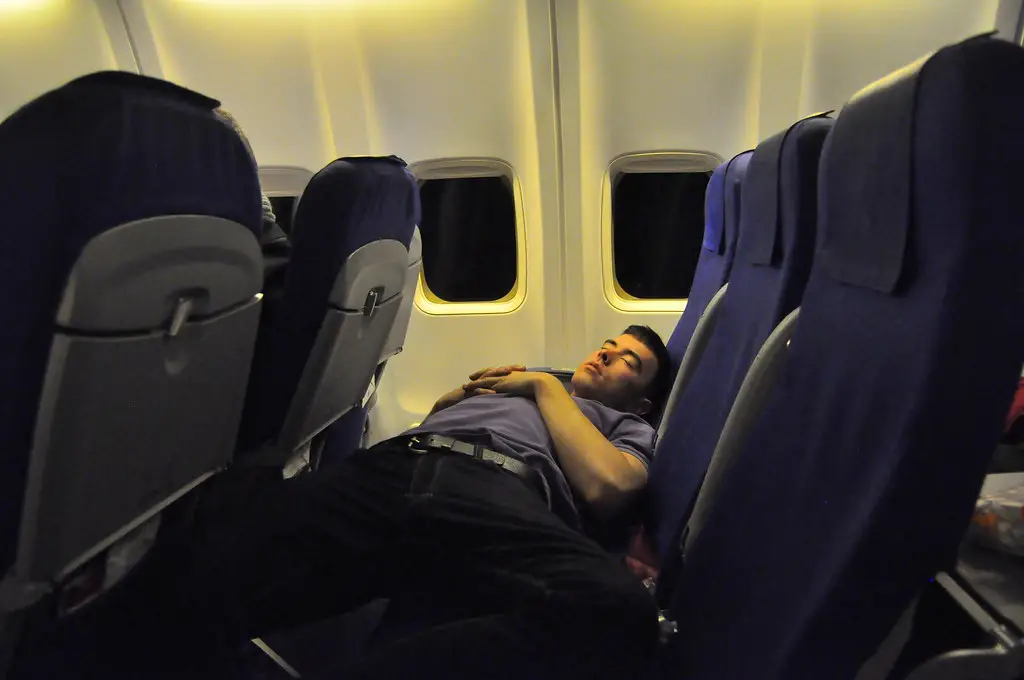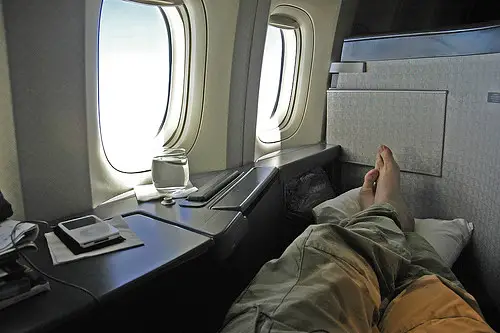Sleeping on an aeroplane’s floor means lying on the ground inside the plane to rest or sleep. It’s not a regular or comfy way to sleep because the aeroplane floor is complex and not meant for sleeping.
Can you sleep on an aeroplane floor? Let’s uncover the cosy secrets and important rules behind Can You Sleep on the Floor of an Airplane?’ So, buckle up as we explore comfy alternatives and learn why the floor isn’t the best place to catch some Zs during your flight adventure.
Sleeping on an aeroplane floor is not a good idea. It’s uncomfortable and can be unsafe during things like turbulence. Airlines have rules against it to keep everyone safe.
Instead, you can bring a unique pillow or choose better seats if you want to sleep better on a plane. It’s essential to stay in your chair with your seatbelt fastened during the flight for your safety.
Is It Comfortable?

One of the foremost concerns when considering sleeping on an aeroplane floor is comfort. Aircraft floors are designed for durability and safety, not passenger comfort. They are typically complex, cold, and far from cosy.
There’s no cushioning or support, making it an uncomfortable option for sleep. Moreover, the floor can be drafty and noisy due to crew and passenger activity. Some passengers have tried bringing their sleeping pads or inflatable cushions to improve comfort.
While these additions may offer relief, they must provide a comfortable sleeping experience. The aeroplane floor is not conducive to a restful night’s sleep, making alternative options more appealing.
The Challenge of Comfort
Sleeping on an aeroplane floor is an attractive option for those seeking a good night’s rest on a long journey. However, comfort is a significant concern. Aircraft floors are not designed with passenger comfort in mind.
They are typically complex, cold, and far from cosy. The lack of cushioning or support can make for an uncomfortable sleep experience. The aisle floor can also be drafty and noisy due to crew and passenger traffic.
Making It Work: Travel Accessories
Some travellers attempt to improve the comfort of sleeping on the aeroplane floor by bringing their sleeping pads or inflatable cushions. While these accessories can relieve some, they may not completely alleviate the discomfort. Ultimately, the bottom of an aeroplane is not conducive to comfortable slumber, and passengers should consider alternative options.
Safety Concerns
Safety is super important when thinking about sleeping on an aeroplane’s floor. You see, aeroplanes can sometimes shake a lot, which might hurt someone on the floor.
Also, if something terrible happens, like a fire or a sudden need to leave the plane, people on the floor could block the way, making it hard for everyone to be safe. And another thing, the floor could be cleaner, and germs can make you sick.
So, staying in your seat with your seatbelt on is way better than staying safe and comfy during the flight.
Turbulence: A Risky Proposition
Safety should always be a top priority when contemplating unconventional sleeping arrangements on an aeroplane. Turbulence can occur unexpectedly during a flight, and passengers on the floor would be at a higher risk of injury. Without seatbelts, they may be tossed around or collide with objects or other passengers, making sleeping on the floor a potentially dangerous choice.
Emergency Evacuation: Impeding Safety
In an emergency, passengers on the floor might obstruct the rapid evacuation of the aircraft. Crew members need clear aisles and access to emergency exits to ensure everyone’s safety. Sleeping on the floor could impede the orderly evacuation, endangering lives.
Health Hazards: Unsanitary Conditions
Another safety concern when sleeping on the aeroplane floor is exposure to unclean surfaces and potential health hazards. Airplanes are not thoroughly cleaned between flights, and the bed can be a breeding ground for germs and bacteria. Passengers who sleep on the floor may risk exposure to unsanitary conditions, potentially leading to health issues.
Airline Policies
Airline policies are like rules that airlines make to keep everyone safe during flights. These rules are fundamental. When it comes to sleeping on the floor of an aeroplane, airline policies say it’s not allowed. They want passengers to stay seated, especially during takeoff, landing, and turbulence. This helps ensure that everyone is protected and can quickly leave the plane in an emergency.
Airline policies also help passengers know what’s expected of them during the flight. They cover things like using seatbelts, staying in designated areas, and following the crew’s instructions. These policies ensure that everyone has a safe and comfortable journey. So, when you’re on a plane, pay attention to these policies and follow them for a smooth and secure trip.
Strict Regulations
Most airlines have stringent policies in place that prohibit passengers from sleeping on the floor of the aircraft. These policies align with safety regulations and ensure passengers remain seated with seatbelts fastened during the flight. Violating these policies can result in warnings, fines, or even being banned from future flights with the airline.
Crew Discretion
Furthermore, the cabin crew can enforce these policies and ensure passenger safety. They may instruct passengers to return to their seats if they observe anyone attempting to sleep on the floor. It’s essential to respect the crew’s instructions and adhere to airline policies to maintain a safe and orderly cabin environment.
Alternative Sleeping Options
If sleeping on the aeroplane floor sounds too challenging, don’t worry! There are other ways to get comfy and sleep well during your flight.
You can fly in special seats called Business or First Class, stretching out and sleeping almost like in a bed. Or, you can bring things like a unique pillow, eye cover, and headphones to make your regular seat cosier.
Some people also use medicines to help them sleep, but it’s important to ask a doctor first. And remember, picking the right flight time can help you get the best sleep in your seat.
The Pursuit of Comfort
While sleeping on the floor of an aeroplane is not a practical or safe option, there are various alternative methods to enhance your in-flight sleep experience:
Upgrading to Business or First Class
One of the most luxurious alternatives is upgrading to premium cabins. Business and First Class offer lie-flat seats or fully reclining beds, providing passengers with the ultimate comfort for long-haul flights. The additional cost may be well worth the investment for travellers seeking a restful journey.
Using Travel Accessories
For passengers in economy class, using travel accessories can significantly improve the sleeping experience. Travel pillows, eye masks, and noise-cancelling headphones can make sleeping in a cramped seat more comfortable. These accessories can help create a more conducive environment for rest.
Conclusion
Can You Sleep on the Floor of an Airplane?” is that it’s not a good idea. Sleeping on the floor of an aeroplane can be uncomfortable and unsafe, especially during turbulence. Airlines have rules against it to keep everyone safe and ensure they stay in their seats with seatbelts fastened.
Instead of sleeping on the floor, there are better options to help you rest during your flight. You can bring special pillows and blankets to make your seat more comfortable. Some people upgrade to better seats with more space, like Business or First Class, where you can lie down almost like in a bed.
Safety is the most important thing when you’re on an aeroplane. So, while the floor might seem tempting for a nap, it’s better to follow the rules and stay in your seat to ensure a safe and comfortable journey.
FAQs
Can I sleep on the floor of an aeroplane if I’m tired?
No, it’s not a good idea. The aeroplane floor could be more comfortable, and it can be risky. It’s safer to stay in your seat with your seatbelt on.
Why is it not safe to sleep on the aeroplane floor?
Sleeping on the floor can be unsafe during turbulence or emergencies. Airlines have rules to protect passengers and make sure everyone is safe in their seats.
Can I bring my cushion to sleep better on the aeroplane?
Yes, you can! Bringing a comfy pillow or cushion is a great idea to make your seat cosier during the flight.
Are there better seats to sleep in on an aeroplane?
There are special seats like Business or First Class where you can stretch out and sleep almost like in a bed. These seats are comfier.
Can I use sleeping pills to sleep better on the plane?
Talking to a doctor before using any medicine on a plane is essential. Some medications might not be safe at high altitudes.
Related Topics:
